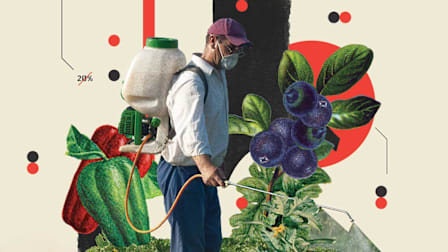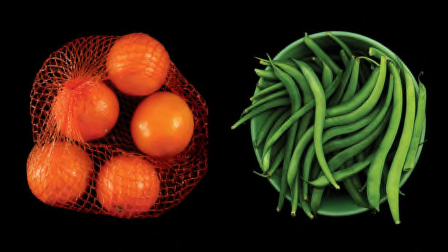Produce Without Pesticides
Some of our favorite fruits and vegetables carry unhealthy levels of chemicals. CR's exclusive ratings reveal how to get the benefits from these foods while minimizing your risk.

When it comes to healthy eating, fruits and vegetables reign supreme. But along with all their vitamins, minerals, and other nutrients can come something else: an unhealthy dose of dangerous pesticides.
Though using chemicals to control bugs, fungi, and weeds helps farmers grow the food we need, it’s been clear since at least the 1960s that some chemicals also carry unacceptable health risks. And although certain notorious pesticides, such as DDT, have been banned in the U.S., government regulators have been slow to act on others. Even when a dangerous chemical is removed from the market, chemical companies and growers sometimes switch to other options that may be just as hazardous.
Consumer Reports, which has tracked the use of pesticides on produce for decades, has seen this pattern repeat itself over and over. “It’s two steps forward and one step back—and sometimes even two steps back,” says James E. Rogers, PhD, who oversees food safety at CR.
To get a sense of the current situation, CR analyzed eight years of data from the Department of Agriculture, which each year tests a selection of conventional and organic produce grown in or imported to the U.S. for pesticide residues. We looked at 62 common fruits and vegetables, including, in some cases, not just fresh versions but also canned, dried, or frozen ones. In our latest update to these ratings, we incorporated data from the USDA’s most recent pesticide residue testing, conducted in 2023, for nine fruits and vegetables, and found changes in pesticide risk levels for some of them. In addition, we included three newly tested items: fresh blackberries, frozen blackberries, and tomatillos.
Our new results continue to raise red flags. Pesticides posed significant risks in about 20 percent of the 62 foods we examined, including popular choices such as bell peppers, blueberries, green beans, potatoes, and strawberries. One food, green beans, had residues of a pesticide that hasn’t been allowed to be used on the vegetable in the U.S. for over a decade. And imported produce, especially some from Mexico, was particularly likely to carry risky levels of pesticide residues.
But there was good news, too. Pesticides presented little to worry about in nearly two-thirds of the foods, including nearly all of the organic ones. Also encouraging: The largest risks are caused by just a few pesticides, concentrated in a handful of foods, grown on a small fraction of U.S. farmland. “That makes it easier to identify the problems and develop targeted solutions,” Rogers says—though he acknowledges that it will take time and effort to get the Environmental Protection Agency, which regulates the use of pesticides on crops, to make the necessary changes.
In the meantime, our analysis offers insights into simple steps you can take to limit your dietary exposure to harmful pesticides, such as using our ratings to identify which fruits and vegetables to focus on in your diet, and when buying organic makes the most sense.
What's Safer, What's Risky, and Why
Sixteen of the 27 fruits and 22 of the 35 vegetables in our analysis had low levels of pesticide risk. Even children and pregnant people can safely eat more than three servings a day of those foods, CR’s food safety experts say. Twelve foods were of moderate risk; up to three servings a day of them are okay.
The flip side: 12 foods presented bigger concerns. Children and pregnant people should consume less than a serving a day of high-risk fruits and vegetables, and less than half a serving per day of very high-risk ones. Everyone else should limit consumption of those foods, too.
To come up with that advice, we analyzed the USDA’s test results for 28,819 individual food samples. We rated the risk of each fruit or vegetable by factoring in how many pesticides showed up in the food, how often they were found, the amount of each pesticide detected, and each chemical’s toxicity. (See our methodology sheet (PDF) for details.)
The Alliance for Food and Farming, a farming industry organization, pointed out to CR that more than 99 percent of foods tested by the USDA contained pesticide residues below the EPA’s legal limits (referred to as tolerances).
But CR’s scientists think many EPA tolerances are set too high. That’s why we use lower limits for pesticides that can harm the body’s neurological system or are suspected endocrine disruptors (meaning they may mimic or interfere with the body’s hormones). CR’s approach also accounts for the possibility that other health risks may emerge as we learn more about these chemicals.
“The way the EPA assesses pesticide risk doesn’t reflect cutting-edge science and can’t account for all the ways the chemicals might affect people’s health, especially given that people are often exposed to multiple pesticides at a time,” says CR senior scientist Michael Hansen, PhD. “So we take a more precautionary approach to help ensure we don’t underestimate risks.”
In our analysis, a fruit or vegetable can contain several pesticides but still be considered low-risk if the combination of the number, concentration, and toxicity of them is low. For example, broccoli fared well not because it had no pesticide residues but because higher-risk chemicals were at low levels and on just a few samples.
Some of the most problematic foods, on the other hand, had relatively few residues but worrisome levels of some high-risk pesticides.
Case in point: blackberries. Although conventional fresh blackberries grown in the U.S. pose only a moderate pesticide-related risk, most blackberries are imported. And imported conventional blackberries are high-risk due mainly to the presence of a pesticide called methamidophos. Methamidophos was banned for use on food crops in the U.S. in 2009, but it can still appear as a residue on foods because it’s a breakdown product of another pesticide, acephate. (Acephate has been banned for use on all food as well, but not until 2024, after the data on blackberries was collected.) Seven out of 127 conventional, imported blackberry samples tested positive for methamidophos in 2023. But methamidophos and acephate are among the pesticides that CR’s experts believe require extra caution because of their potential for serious health risks.
Green beans are another example. They qualify as high-risk primarily due to the presence of acephate and/or methamidophos. Only 4 percent of conventional, domestic green bean samples were positive for one or both—but their pesticide levels were often alarmingly high. In one sample from 2022 (the most recent year for which data was available for green beans), methamidophos levels were more than 100 times the level CR’s scientists consider safe; in another, acephate levels were 7 times higher. And in some 2021 samples, levels were higher still.
This is especially troubling because neither chemical should be on green beans at all: Growers in the U.S. have been prohibited from applying acephate to green beans since 2011 (and, again, methamidophos to all food since 2009).
“It’s true that when you buy green beans or blackberries, there’s a low chance that that particular purchase will come with a high risk from pesticides,” says Rogers. “But if it does, you could be getting a higher dose than you should.”
In some cases a food qualifies as high-risk because of several factors, such as high levels of a moderately dangerous pesticide on many samples. Example: chlorpropham on potatoes. It’s not among the most toxic pesticides—but it was on more than 90 percent of tested potatoes and at a very high average residue level.
The most recent data from the USDA show some improvements as well. For example, watermelon’s risk level dropped from high to moderate. That’s because the watermelon samples, on average, had lower levels of a particularly harmful pesticide called oxamyl (or its breakdown product oxamyl oximine) than they had previously.
CR's Produce Ratings
Fruits and vegetables are listed alphabetically in the chart below, showing the risk from pesticides in their conventional and organic versions, as well as whether they are grown domestically or imported. (A blank space means we did not have residue data for that food.)
Risk levels correspond to the number of servings a 35-pound child (about the size of a 4-year-old) could safely consume each day, and are based on a pesticide’s chronic toxicity. Serving sizes represent a child’s portion: about two-thirds of an adult serving.
When deciding on the conventional fruits and vegetables to buy, CR recommends those rated as very low, low, or moderate risk. When possible, replace a food rated high or very high with a lower-risk one, or choose organic. Keep in mind that the most risk comes from repeated servings over time. If you usually choose produce with the best ratings, you can reduce the chance of future harm. (Download a printable version of CR’s guide to pesticides in produce to take with you to the grocery store.)
How Pesticides Can Harm You
Pesticides are one of the only categories of chemicals we manufacture “specifically to kill organisms,” says Chensheng (Alex) Lu, PhD, an affiliate professor at the University of Washington in Seattle who researches the health effects of pesticide exposure. So it’s no surprise, he says, that pesticides used to manage insects, fungi, and weeds may harm people, too.
While there are still open questions about exactly how and to what extent chronic exposure to pesticides can harm our health, scientists are piecing together a compelling case that some can, drawing on a mix of laboratory, animal, and human research.
One type of evidence comes from population studies looking at health outcomes in people who eat foods with relatively high pesticide levels. A 2023 recent review in the journal Environmental Health, which looked at six such studies, found evidence linking pesticides to increased risks of cancer, diabetes, and cardiovascular disease. Scientists are also deploying genomic testing methods to identify specific markers of DNA damage associated with pesticides, says CR’s Hansen. “Such research could help to explain the reasons that observational studies so often find that pesticide exposure is linked to increased risks of chronic diseases,” he says.
Stronger evidence of pesticides’ dangers also comes from research looking at people who may be particularly vulnerable to pesticides, including farmworkers and their families. In addition to the thousands of workers who become ill from pesticide poisonings every year, studies have linked on-the-job use of a variety of pesticides with a higher risk of Parkinson’s disease, breast cancer, diabetes, and many more health problems.
Other research found that exposure during pregnancy to a common class of pesticides called organophosphates was associated with poorer intellectual development and reduced lung function in the children of farmworkers.
Pregnancy and childhood are times of particular vulnerability to pesticides, in part because certain pesticides can be endocrine disruptors. Those are chemicals that interfere with hormones responsible for the development of a variety of the body’s systems, especially reproductive systems, says Tracey Woodruff, PhD, a professor of environmental health sciences at the University of California San Francisco. Another concern is that long-term exposure to even small amounts of pesticides may be especially harmful to people with chronic health problems, those who live in areas where they are exposed to many other toxins, and people who face other social or economic health stresses, says Jennifer Sass, PhD, a senior scientist at the Natural Resources Defense Council.
That’s one of the reasons, she says, regulators should employ extra safety margins when setting pesticide limits—to account for all the uncertainty in how pesticides might harm us.

Photo: Sarah Anne Ward Photo: Sarah Anne Ward
How to Stop Eating Pesticides
While our analysis of USDA pesticide residue data found that some foods still have worrisome levels of certain dangerous pesticides, it also offers insights into how you can limit your pesticide exposure now, and what government regulators should do to fix the problem in the long term.
Eat Lots of Low-Risk Produce
A quick scan of our ratings chart above makes one thing clear: There are lots of good options to choose from.
“That’s great,” says Amy Keating, a registered dietitian at CR. “You can eat a variety of healthy fruits and vegetables without stressing too much about pesticide risk, provided you take some simple steps at home.”
Your best bet is to choose produce rated low-risk or very low-risk in our analysis and, when possible, opt for organic instead of riskier foods you enjoy. Or swap in lower-risk alternatives conventional for riskier ones. For example, try snap peas instead of green beans, U.S. grown strawberries or blackberries in place of blueberries, cabbage or dark green lettuces for kale, and, when possible, a sweet potato instead of a white one.
But you don’t need to eliminate higher-risk foods from your diet. Eating them occasionally is fine. “The risk of harm, even from the most problematic produce, comes from exposure during vulnerable times such as pregnancy or early childhood, or from repeated exposure over years,” Rogers says.
Switch to Organic When Possible
A proven way to reduce pesticide exposure is to eat organic fruits and vegetables, especially for the highest-risk foods. We had information about domestic, organically grown versions for 44 of the 62 foods in our analysis. Nearly all had low or very low pesticide risk, and only one domestically grown food—fresh spinach—posed even a moderate risk.
The low-risk ratings for organic fruits and vegetables indicate that the USDA’s organic certification program, for the most part, is working.
Pesticides aren’t totally prohibited on organic farms, but they are sharply restricted. Organic growers may use pesticides only if other practices—such as crop rotation—can’t fully address a pest problem. Even then, farmers can apply only low-risk pesticides derived from natural mineral or biological sources that have been approved by the USDA’s National Organic Program.
When foods contain lower concentrations of pesticide residues and residues of fewer pesticides overall, it means less pesticide enters our bodies. Multiple studies have shown that switching to an organic diet quickly reduces dietary exposure. Organic farming protects health in other ways, too, especially for farmworkers and rural residents, because pesticides are less likely to drift into the areas where they live or to contaminate drinking water.
And organic farming protects other living organisms, many of which are even more vulnerable to pesticides than we are. For example, organic growers can’t use a class of insecticides called neonicotinoids, a group of chemicals that may cause developmental problems in young children—and is clearly hazardous to aquatic life, birds, and important pollinators including honeybees, wild bees, and butterflies.
The rub, of course, is price: Organic food tends to cost more—sometimes much more.
“That’s why, while we think it’s always worth considering buying organic produce, it’s most important for the handful of fruits and vegetables that pose the greatest pesticide risk,” Rogers says. He also says that opting for organic is most crucial for young children and during pregnancy, when people are extra vulnerable to the potential harms of the chemicals.
Watch Out for Some Imports
Overall, imported fruits and vegetables and those grown domestically are pretty comparable, with roughly an equal number of them posing a moderate or worse pesticide risk. But imports, particularly from Mexico, can be especially risky.
Nine imported foods in our analysis pose a very high risk, compared with just four domestic ones. And of the 100 individual fruit and vegetable samples in our analysis with the highest pesticide risk levels, 71 were imported. Most of those—57—came from Mexico, and the majority involved strawberries (usually frozen) or green beans (nearly all contaminated with methamidophos, one of the pesticides that’s prohibited for use on green beans headed to the U.S.).
A spokesperson for the Food and Drug Administration told CR that the agency is aware of the problem of acephate contamination on green beans from Mexico. Between 2017 and 2025, the agency has issued import alerts on 17 Mexican companies because of acephate or methamidophos found on green beans. These alerts allow the FDA to detain the firms’ food shipments until they can prove the foods are not contaminated with the illegal pesticide residues in question. The Fresh Produce Association of the Americas, which represents many major importers of fruits and vegetables from Mexico, did not respond to a request for comment.
Rogers says, “Clearly, the safeguards to prevent food contaminated with acephate and methamidophos aren’t working as they are supposed to.” As a result, “consumers are being exposed to much higher levels of very dangerous pesticides than they should.” Because of those risks, he suggests checking the packaging on green beans and strawberries for the country of origin, and consider other sources, including organic.

Photo: Sarah Anne Ward Photo: Sarah Anne Ward
Solving the Pesticide Problem
Perhaps the most reassuring—and powerful—part of CR’s analysis is that it demonstrates that the risks of pesticides are concentrated in just a handful of foods and pesticides.
Just two broad classes of insecticides, organophosphates and a similar type of pesticide called carbamates, were responsible for most of the risk. The most significant green bean and blackberry contaminants are acephate and methamidophos, both organophosphate insecticides. The most significant contaminant in bell peppers is oxamyl, a carbamate.
“These same two families of insecticides have consistently caused the majority of pesticide dietary risk over the last 30 years in the foods the USDA has tested,” says Charles Benbrook, PhD, an independent expert on pesticide use and regulation who consulted with CR on our pesticide analysis.
“That makes trying to solve the problem much more manageable, by letting regulators and growers know exactly what they need to concentrate on,” says Brian Ronholm, head of food policy at CR.
Organophosphates and carbamates became popular after DDT and related pesticides were phased out in the 1970s and 1980s. But concerns about these pesticides soon followed. While the EPA has removed a handful of them from the market and lowered tolerance limits on a few others, many organophosphates and carbamates are still used on fruits and vegetables and are still posing high or very high risks.
Take, for instance, phosmet, an organophosphate that is the main culprit behind blueberries’ poor score. Until recently, phosmet rarely appeared among the most concerning samples of pesticide-contaminated food. But in recent years, it has become a main contributor to pesticide risk in some fruits and vegetables, according to our analysis.
“That’s happened in part because when a high-risk pesticide is banned or pushed off the market, some farmers switch to a similar one still on the market that too often ends up posing comparable or even greater harm,” Benbrook says.
CR’s food safety experts say our current analysis has identified several ways the EPA, FDA, and USDA could protect consumers better.
That includes doing a more effective job of working with agricultural agencies in other countries and inspecting imported food, especially from Mexico, and conducting and supporting research to more fully elucidate the risks of pesticides. In addition, the government should provide more support to organic farmers and invest more federal dollars to expand the supply of organic food, which would, in turn, lower prices for consumers.
But one of the most effective and simple steps the EPA could take to reduce overall pesticide risk would be to ban the use of any organophosphate or carbamate on food crops.
The EPA told CR that “each chemical is individually evaluated based on its toxicity and exposure profile,” and that the agency has required extra safety measures for several organophosphates.
But CR’s Ronholm says that approach is insufficient. “We’ve seen time and again that doesn’t work. Industry and farmers simply hop over to another related chemical that may pose similar risks.”
Canceling two whole classes of pesticides may sound extreme. “But the vast majority of fruits and vegetables eaten in the U.S. are already grown without hazardous pesticides,” Ronholm says. “We just don’t need them. And the foods American consumers eat every day would be much, much safer without them.”
Editor’s Note: This article was updated to include new pesticide data from the USDA. It originally appeared in the May/June 2024 issue of Consumer Reports magazine.




















